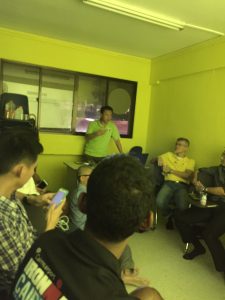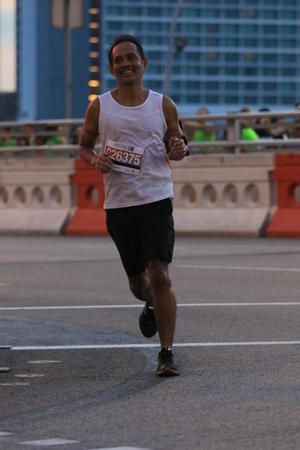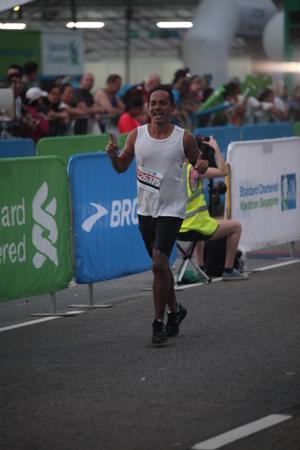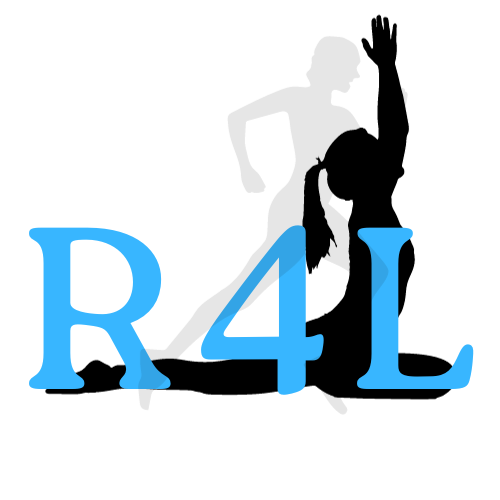Sometimes we need the wisdom that comes from 50 years of living to define the next 35 fulfilling years. Live each day with purpose so the next day is lived with insight.
Sanjay C Kuttan, my friend, author
The culmination of the Singapore running calendar is the Standard Chartered Singapore Marathon. Many runners in Singapore will close their running season upon completing this race.
Before going further a word for a fallen runner.
My prayers and thoughts are with the family of John Gibson. John ran a good race.
” and to Him shall we return”. Amen.
For many years now, I ran the marathon without really setting a time goal. I felt that getting on in age, I do not need to prove myself. I had done my PB, not spectacular but a respectable one. Then I find myself in a running rut. Virtually I was on auto pilot clocking miles at a comfortable 7min pace. Enjoying the scenery in touristy long comfortable runs.
I was not really sure when it hit me or even if it was any particular incidence that jolted me but I decided to see if I could clock a post 45 year old PB. To do that, I took a leaf from Murakami who, in his book ‘What I Talk About When I Talk About Running’ described how, he too had gone on autopilot and how he had gone back to basics in his quest for better timings.
Take one step back to be able to take two steps forward. I had to step back, assess my resources and condition, plan the process, then execute.
So I decided the plan was to run a post 45 PB for the half marathon. If I could do a good time, then I know that, at 50+, I still have something in the tank for a respectable 4hour marathon in years to come.
I went about goal setting. Looking at my 5km timing I figured I would be good for a 2hr 10mins half. Then I set about a devising a training plan. I gleaned gems, bits and bobs and real information from my running mates, principally Enrico Varella and latterly Prof Kua Harn Wei, Singapore’s first Double-Ironman, Quadruple-Ironman and Deca-Ironman. I also read Pierce et al ‘Run less, run faster’, these guys are the experts at FIRST whose training programme is built around 3 key runs plus 2 cross training sessions per week.

Harn Wei sharing his deca tri training with us
They all had the same message, run less to run faster. But you need to up the intensity. And each workout has to be purposeful. Meaning each session you either build endurance, improve your VO2max, or improve running speed.
Borrowing heavily from the guys at FIRST, I embarked on the plan. I had started training late in the season so I had 8 weeks to hit my target 2:10 half. I will write about my training in detail later. Briefly though it centers around 1 long interval session, 1 tempo session and 1 long run per week. Upping the intensity meant keeping to the pace, intervals are all run at short tempo pace or faster, tempo runs are at short and medium tempo, while the long runs are at medium tempo.
Upshot was I missed the target by 1 minute 50s but that was due more to race strategy and circumstances during the race. I had planned to start slow and build up pace in the 2nd third of the race. I totally misjudged my starting pace and the traffic didn’t help. I was actually much slower in the beginning third. But once I got to the 2rd third of the race and the traffic had thinned, I was able to get into the pace and rhythm I wanted.

in the rhythm
Finishing strong I did Enrico’s moving goal post finish line pose. Having taken a step back, I now know that I can make an assault at a PB.

moving goal posts
After the race, recovering with my favourite beverage, my mind was thinking about how running parallels management. Manage your resources, manage your weaknesses, manage your strength, manage your environment.

Recovering. photo credit – Enrico Varella
Stepping back does not have to mean regression. Sometimes you need to take 1 step back to be able to take 2, perhaps 4 steps forward.
Sanjay, who I have chosen to quote in my opening paraphrase is a friend from NUS. Sanjay’s short story Dying Alone is in Balik Kampung Vol 3C, you can get that here.
Race photo credits marathon-photos.com
